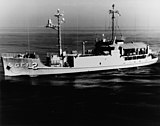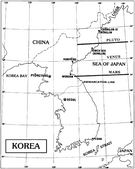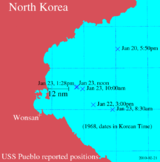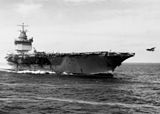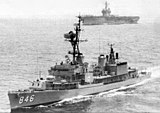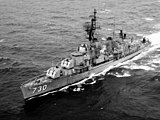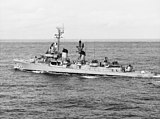
A | B | C | D | E | F | G | H | CH | I | J | K | L | M | N | O | P | Q | R | S | T | U | V | W | X | Y | Z | 0 | 1 | 2 | 3 | 4 | 5 | 6 | 7 | 8 | 9
| Operation Formation Star | |
|---|---|
| Part of Cold War, Korean Conflict, Pueblo Incident | |
 Defender Station | |
| Type | Contingency operations[Note 1] |
| Location | |
| Planned by | U.S. Seventh Fleet |
| Commanded by | Rear Admiral Horace H. Epes, Jr. Commander Task Force 71 (CTF-71) |
| Target | North Korea |
| Date | January 25, 1968 to March 22, 1968[1][2][3] |
| Executed by | Task Force 71 (TF-71) |
| Outcome | Show of force |
Operation Formation Star was the code name for the emergency re-deployment of U.S. Seventh Fleet warships to the Sea of Japan off the eastern coast of North Korea following that country's seizure of the USS Pueblo (AGER-2) in international waters on 23 January 1968.[Note 2]
This surge deployment was the largest build-up of U.S. naval forces around the Korean Peninsula since the end of the Korean War. Still, Operation Formation Star placed considerable strain on the Seventh Fleet's support for the Vietnam War during the Tet Offensive, particularly its aircraft carrier operations at Yankee Station in the Gulf of Tonkin.
Operation Formation Star was executed in conjunction with Operation Combat Fox, a surge deployment of additional land-based combat aircraft squadrons to the U.S. Fifth Air Force in the Far East. Additionally, the Pueblo Crisis saw a limited presidential-authorized call-up of U.S.-based units of the Naval Reserve, Air Force Reserve, and Air National Guard to active duty, the first such call-up since the Berlin Crisis of 1961.[4]
Although a wide range of military options were considered, the Johnson Administration elected to resolve the Pueblo crisis diplomatically, with Operation Formation Star helping to provide a "measured show of force" during the Pueblo crisis.[5][6]
Background

Tensions along the Korean demilitarized zone (DMZ)
Also referred to as the Second Korean War, the Korean DMZ Conflict was a series of low-level armed clashes between North Korean forces and the forces of South Korea and the United States, largely occurring between 1966 and 1969 at the Korean DMZ.[8] The number of incidents along the DMZ jumped from 37 in 1966 to 435 in 1967, with a combined 1967 total of 371 fatalities involving North Korea, South Korea, and United Nations forces while there were no fatalities in 1966 (see chart).[Note 3][9] Also, during 1967, there were two sabotage attempts to disrupt South Korea railroad operations, the first such attempts since the end of the Korean War. Additionally, in 1967, a South Korean patrol vessel was sunk by North Korea shore batteries over a fishing dispute, with thirty-nine of the 79-man crew killed.[10]
Finally, in the most overt incident to date, North Korean commandos from Unit 124 unsuccessfully attempted to assassinate the South Korea president Park Chung Hee at the presidential residence Blue House in Seoul, South Korea, on 21 January 1968.[11][12]
Operation Clickbeetle
Operation Clickbeetle was the code-name for United States electronic and radio intelligence-gathering operations by small converted coastal cargo ships that operated close to potential enemies' coastline in international waters. The first vessel in this program was Banner and the second was the Pueblo. Beginning in 1965, the Banner completed fifteen intelligence missions involving the Soviet Union and China, with only three missions that also included North Korea. While both China and the Soviet Union in particular challenged Banner's presence off their coasts, the North Koreans virtually ignored the U.S. vessel. Banner and Pueblo were under the direct operational control of the Commander, Naval Forces Japan Rear Admiral Frank L. Johnson through the Task Force 96 command staff.[13][14]
Operational summary
On 11 January 1968, USS Pueblo left Sasebo, Japan, and headed northward through the Tsushima Strait into the Sea of Japan. Pueblo's specific orders were to intercept and conduct surveillance of Soviet Pacific Fleet activity in the Tsushima Strait and to gather signal and electronic intelligence from North Korea. To maintain a low profile, no naval escort was provided nor were any land-based interceptor jets on stand-by alert for Pueblo's mission. After an uneventful mission to date, Pueblo was observed by a North Korea sub-chaser on 21 January 1968 in international waters off Wonsan. On 23 January 1968, the Pueblo was shadowed by two North Korea fishing trawlers before being intercepted and boarded by a North Korean SO1 class submarine chaser and three P 4-class torpedo boats, all outside North Korea's territorial waters.[15][16]
Initial response

On the day of the Pueblo's seizure, 23 January 1968, the closest U.S. naval force was Task Group 77.5 under the command of Rear Admiral Horace H. Epes, Jr. (pictured),[Note 4][17] consisting of the nuclear-powered attack aircraft carrier Enterprise, the nuclear-powered guided-missile frigate Truxtun, and the guided-missile frigate Halsey. At the time of the initial alert, the task group was steaming in the East China Sea en route to Yankee Station off North Vietnam; it was approximately 550 nautical miles (1,020 km; 630 mi) from the last reported position of the Pueblo or 470 nautical miles (870 km; 540 mi) from Wonsan, the nearest North Korean seaport to Pueblo.[18][17][19][20] Now re-designated Task Group 70.6, the Enterprise task group was ordered to proceed "at best speed" to the southern entrance of the Tsushima Strait. Also, the Pueblo's sister-ship, Banner, was ordered to suspend its intelligence-gathering mission and return to Yokosuka, Japan, immediately.[21]

A number of factors prevented an immediate response from the Enterprise's embarked Carrier Air Wing Nine of 85 aircraft.[17][Note 5] The air wing's aircraft had sustained damage from a recent typhoon and those remaining 35 operational strike aircraft had to be re-spotted on the flight deck and armed with air-to-surface ordnance.[20][22] Additionally, the ship could not stage replacement aircraft through Japan due to the status of forces agreement that prohibited the combat use of U.S. military aircraft re-deployed from a neutral nation.[17][22] Another factor was that Wonsan was protected by 14 anti-aircraft batteries, two surface-to-air missile sites, and up to 75 MiG fighters.[23]
Later on 23 January 1968, CINCPAC Admiral Ulysses S. Grant Sharp, Jr., requested authorization from the U.S. Joint Chiefs of Staff for Task Group 70.6 to carry out photographic reconnaissance of Wonsan to determine the location of the Pueblo.[24] Upon hearing about the seizure of the Pueblo, Admiral John J. Hyland, Jr., recognized the possibility of sending a warship into Wonsan harbor to board and recapture the Pueblo.[25] Accordingly, Hyland directed his U.S. Pacific Fleet headquarters staff to order the U.S. Seventh Fleet to divert a destroyer and "prepare to engage in operations that may include towing Pueblo and/or retrieval of Pueblo crew/provide air cover as appropriate." Vice Admiral William F. Bringle ordered his Seventh Fleet staff to deploy the destroyer Higbee (pictured) to Wonsan as a contingency for such an operation, with a second destroyer to be sent as a back-up.[26] Additionally, on that same date, Lieutenant General Seth J. McKee, of the Fifth Air Force ordered a strike force of twelve F-105 fighter-bombers to Osan Air Base in South Korea with orders to sink the Pueblo in Wonsan harbor.[27][28][Note 6]
Early on 24 January 1968, the U.S. Pacific Fleet headquarters ordered Task Group 70.6 to remain below the 36th parallel North (Defender Station) and take "no overt action until further informed." Subsequent orders directed the Enterprise task group to the Korea Strait, and to gain additional sea room, the task group temporarily withdrew to the East China Sea. Land-based anti-submarine patrols in support of Task Group 70.6 were limited to a two-plane barrier patrol. Additionally, all signal intelligence-gathering flights over the Yellow Sea and the Sea of Japan were temporarily suspended until further notice. Finally, the Higbee was recalled from the Wonsan area.[29]
On the evening of 25 January 1968, a high-altitude A-12 reconnaissance aircraft overflew Wonsan harbor and confirmed that the Pueblo was anchored there and surrounded by North Korean naval vessels (pictured above).[30][31]
Crisis management

The U.S. Pacific Command and U.S. Pacific Fleet planning staffs offered a number of military options in response to the Pueblo crisis. These options were forwarded to the U.S. Joint Chiefs of Staff and the rest of the National Command Authority apparatus while the U.S. Seventh Fleet and U.S. Fifth Air Force command staffs developed contingency plans.[32][33][34]
On Wednesday morning, 24 January 1968, Rear Admiral William McClendon, the deputy director for Operations (J-3) on the Joint Staff, reported back to the Joint Chiefs of Staff (pictured) about the disposition and availability of military forces in the vicinity fn the Korean peninsula, as well as offering the following four recommendations:
- Demand the return of the Pueblo and its crew via U.N.-DPRK talks at Panmunjom.
- Send an unarmed tugboat to Wonsan to retrieve the Pueblo.
- Conduct air-naval show of force off Wonsan.
- Execute selective air strikes against North Korea military and industrial targets.
The J-3 report emphasized that option 4 must be a prerequisite before options 2 and 3 can be considered, and that other potential options, such as the seizure of North Korean naval and merchant marine ships on the high seas, offered a “small chance of success, half measures, and less worthiness than should be expected of a great power.” The Joints Chiefs met later that day to consider how any mobilization to meet this unfolding Pueblo crisis would affect U.S. military operations in Vietnam.[35]
On Friday, 26 January 1968, the inter-agency Korea Working Group met to discuss the Pueblo crisis, which included consideration of the following military, diplomatic, and economic options:[32][33][34]

- Selected air strikes on North Korea. This option involved ninety-two U.S. Navy, U.S. Air Force, and South Korean air force aircraft striking the North Korean air base at Wonsan and the near-by Munp’yong-ni naval base.
- Naval blockade of Wonsan. Leveraging carrier-based air cover, U.S. and possibly South Korean naval units could impose a blockade within Wonsan's twelve-mile limit. To achieve air superiority, strikes against North Korean military airfields would “quite possibly” be required.
- Mine Wonsan Harbor. Carrier-based A-6 attack aircraft would fly seventeen sorties to drop eighty-three mines in one night, and thereafter the A-6 aircraft would “reseed” the minefield as necessary.
- Seize North Korean vessels. The option would act as retaliation in kind, seizing either a North Korean merchant vessel or a warship, and then using that vessel as a bargaining chip for the release of the Pueblo and its crew.
- Sail USS Banner into the area where Pueblo had been seized. This would demonstrate U.S. determination to exercise freedom of the seas positing the Banner a minimum of thirteen miles from the North Korean coast for eight days (see map). Two destroyers, a cruiser, and possibly a South Korean unit would escort the Banner, and carrier aircraft would fly cover overhead. U.S. Air Force aircraft in South Korea would be on “strip alert” status for immediate readiness to take off.
- Recover cryptographic material jettisoned by Pueblo. This recovery operation involve a U.S. Navy tug and mine warfare vessels from Sasebo, Japan, plus special detection gear from the United States. Carrier-based and land-based aircraft would provide air cover. The salvage unit would only operate during daylight, and the entire operation would terminate after ten days.
- Conduct airborne reconnaissance. This option involved flying reconnaissance missions in an attempt to convince North Korea that the United States was preparing for military operations, including electronic warfare missions.
- Inform the Soviets of actual or possible military moves. This option would use the Soviet Union as a "back channel" to warn the North Korea against further provocations.
- Raid across the Demilitarized Zone. This option involved a combine U.S.-ROK armored force raiding a major North Korean military post near the DMZ.
- Economic pressure on North Korea. This option involved a total trade embargo by the United States and its allies, particularly a cessation of Japanese imports from North Korea and elimination of wheat exports.
On 29 January 1968, a senior advisory panel reviewed the working group's list of options and recommended a diplomatic, non-military approach to ending the Pueblo crisis. To support this diplomatic effort, Operation Formation Star was initiated, with the Enterprise-led Task Group 70.6 serving initially as its centerpiece.[33][34]
- Task Group 70.6
| Escort screen | Carrier Air Wing Nine (CVW-9) squadrons embarked aboard flagship USS Enterprise (CVAN-65) | |||||
|---|---|---|---|---|---|---|
| USS Truxtun (DLGN-35) | USS Higbee (DDR-806) | Fighter Squadron 96 (VF-96): 16 F-4B | Attack Squadron 113 (VA-113): 14 A-4E | Reconn. Attack (Heavy) Squadron 1 (RVAH-1): 6 RA-5C | Airborne Early Warning Squadron 112 (VAW-112): 4 E-2A | |
| USS Halsey (DLG-23) | USS Collett (DD-730) | Fighter Squadron 92 (VF-92): 13 F-4B | Attack Squadron 56 (VA-56): 13 A-4E | Heavy Attack Squadron 2 (VAH-2), Det. 65: 6 KA-3B | Helicopter Combat Squadron 1 (HC-1), Det. 65: 3 UH-2C | |
| USS Ozbourn (DD-846) | USS O'Bannon (DDE-450) | ——— | Attack Squadron 35 (VA-35): 12 A-6A | AEW Squadron Thirteen (VAW-13), Det. 65: 3 EKA-3B | Carrier Onboard Delivery (COD): 1 C-1A | |

Effective 25 January 1968, in conjunction with Operation Combat Fox, Operation Formation Star was initiated. Both operations represented a major surge deployment of U.S. naval and air forces into the Sea of Japan region off the eastern coast of North Korea, the largest since the end of the Korean War.[1][3] Taken together, the purpose of this build-up/call-up was to provide a "measured show of force" in support of the diplomatic effort to resolve the Pueblo crisis peacefully.[5][6]
Although not directly related to Operation Formation Star, the Republic of Korea Navy also dispatched nineteen ships and two fast patrol boats to sixteen patrol zones around South Korea.[36] Likewise, at the United Nations Command in South Korea, General Charles H. Bonesteel III was concerned about border security and recommended two U.S. destroyers and maritime patrol aircraft reinforce the South Korean naval and air units conducting maritime patrol and interdiction.[37]
Task Force 71

On 25 January 1968, the newly augmented Enterprise-led Task Group 70.6 sailed through Tsushima Strait and into the Sea of Japan. The task group would operate below 36th parallel North during Operation Formation Star.[38][39] Between 24 and 26 January 1968, the destroyers Higbee, Collett, O'Bannon, and Ozbourn joined Task Group 70.6.[29]
On 27 January 1968, Task Group 77.7 led by the attack aircraft carrier Ranger was detached from duty with Task Force 77 at Yankee Station off North Vietnam and was ordered to the Sea of Japan as part of Operation Formation Star, arriving at Defender Station on 31 January 1968.[16][40] In order to do so, the tour of duty for the attack aircraft carrier Coral Sea with the U.S. Seventh Fleet was extended by another month.[41] Likewise, the support aircraft carrier Yorktown and its Task Group 70.0 were ordered to forego a scheduled port-call in Japan and was diverted to the Sea of Japan.[16][42][43] By 1 February 1968, Yorktown, Ranger and Enterprise were operating in the Sea of Japan as Task Force 71 under the command of Rear Admiral Horace H. Epes, Jr., with the Enterprise as his flagship.[17][36][44]
Task Force 71 was organized into a two-carrier strike group (Enterprise and Ranger), a surface action group, and an anti-submarine warfare (ASW) unit centered around the Yorktown and her escorts.[45][43] As the surface sub-surface surveillance operations coordinator (SSSC) for Task Force 71, the Yorktown and its embarked Carrier Anti-Submarine Air Group 55 (CVSG-55) provided near-continuous anti-submarine warfare (ASW) and anti-shipping air operations throughout February 1968, with the exception of a single period of nine hours when flight operations were suspended owing to inclement winter weather conditions (pictured).[43]
The area air defense for Task Force 71 was greatly enhanced when the guided-missile cruiser Chicago (pictured) was detached from PIRAZ duty off Vietnam for operations in the Sea of Japan on 28 January 1968. Equipped with modernized electronic systems, an improved combat information center using the Naval Tactical Data System (NTDS), and long-range RIM-8 Talos anti-aircraft missiles, Chicago coordinated air activities for the TF-71 aircraft carriers.[16][46] The Canberra and Providence were the other two guided-missile cruisers assigned to Task Force 71, joining the guided-missile frigates Bainbridge, Halsey, and Dewey.[16]

